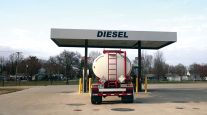Diesel Fuel Average Price Dips 2¢ to $4.104 a Gallon After Commodity Prices ‘Crash’
By Timothy Cama, Staff Reporter
The average price for a gallon of U.S. retail diesel declined last week for only the third time this year, dipping 2 cents to $4.104, the Department of Energy reported.
It was the largest weekly dip since August but followed a 2.6-cent increase the previous week, DOE said after its May 9 survey of fueling stations. Diesel has risen 15 out of the 18 weeks so far this year and is 81 cents higher than at the start of 2011 and 97.7 cents — or 31% — higher than a year ago.
The main factor behind the 2-cent drop was the “commodity crash” the week before, in which multiple commodities, including crude oil, dropped significantly, said Neil Gamson, an economist with DOE’s Energy Information Administration.
“Some of this trickled down to diesel prices,” Gamson said. “Assuming that refiner margins don’t change too much, we could see some more diesel price decreases.”
DOE also said the average price of regular gasoline continued its long string of increases, gaining 0.2 cents to $3.965 a gallon. Gasoline has risen in 16 of the 18 weeks so far this year and has not declined since March 21, DOE figures show. Gasoline surged 8.4 cents the previous week and is $1.06 — or 36% — higher than the comparable time a year ago.
Burns Motor Freight relies heavily on driver behavior to conserve fuel, CEO Fred Burns Jr. said last week. “There’s not much we can do to control the price, so we’ve got to try to control the consumption,” he said.
Burns issues bonuses to drivers who meet certain fuel-conservation goals each month, and the CEO estimated that 35% to 40% of drivers meet those goals.
But fuel prices still take a toll on the flatbed carrier, which is based in Marlinton, W.Va., Burns said. The carrier gets much of its business from the housing market, which still has not fully recovered from the recession. The company, therefore, runs “a few more empty miles than normal,” Burns said.
“I’m concerned with a double-dip recession if this continues, because the consumer just cannot afford to pay this additional fuel cost,” he added.
“The volatile prices are taking everyone by surprise,” Ken Kram, compliance director at Go-To Transport Inc., told Transport Topics.
“We’re doing everything we can to deal with the situation. Fuel surcharges only go so far, and typically they’re a week behind the increases,” he said.
Go-To, a Bay City, Mich.-based truckload carrier, calculates its fuel surcharges from the national diesel average, since it operates throughout the continental United States and Canada, Kram said.
As for the 2-cent decrease last week, Kram was not convinced it would provide much relief.
“The price is fluctuating so much. It went down last week, but what’s next week going to bring?” he said May 10. “It’s on everybody’s mind daily. What’s going to happen today? What’s going to happen to the price of a barrel [of oil] today? What’s going to happen to the price of diesel today?”
Kram tries to negotiate fuel discounts with the truck stops his drivers frequent, but he’s not always successful.
“Like everybody else, they’re there to make a profit,” he said. “They give what they can, and we go from there.”
Crude oil fell below $100 per barrel on the New York Mercantile Exchange on May 11 after the International Energy Agency said oil demand had fallen for the first time this year.
Crude inventories rose by 3.78 million barrels to 370.3 million barrels, a two-year high, during the week May 1, the Department of Energy reported. The inventory level also contributed to the drop in trading prices, Bloom-berg News said.
Crude reached $103.88 per barrel May 10 on concerns that flooding on the Mississippi River would disrupt oil refining and fuel transportation, after a two-day climb.
The “commodity crash” the week before sent oil down to $97.18 a barrel May 6, capping a week of declines. On April 28, it hit $113.93, its highest price since September 2008.
Meanwhile, EIA in its latest Short-Term Energy Outlook predicted diesel will average $3.89 a gallon in 2011. It was a reduction of 9 cents from its prediction the month before.
However, EIA’s Gamson warned that the Mississippi River flooding could cause diesel refineries to cut or stop production soon.
“They have some time to prepare,” he said, adding that preparation would likely lessen long-term effects of the flooding.
During 2012, diesel will average $3.93, a 14-cent drop from its last forecast, EIA said. Gasoline will average $3.63 per gallon in 2011 and $3.66 in 2012, increases of 7 and 14 cents, respectively, from the last forecast.




